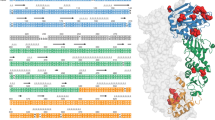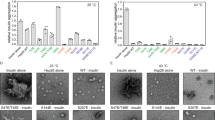Abstract
Exposure of cells or tissues of various living organisms to elevated temperatures induces the synthesis of a family of specific proteins called heat-shock proteins (HSPs)1–3. This phenomenon has so far been investigated mostly with respect to the induction mechanism of these HSPs4,5. However, little is known about the function of such proteins, although it has been suggested that they are involved in the acquisition of thermal tolerance3. We have recently suggested that a specific class of HSPs may function as negatively regulatory molecules in the growth of eukaryotic cells6–8, and that a HSP of relative molecular mass (Mr) 48,000 (HSP48) from the yeast Saccharomyces cerevisiae may be involved in both thermal tolerance and growth control in this organism8. We now present evidence that S. cerevisiae HSP48 is an isoprotein of a glycolytic enzyme, enolase (EC 4.2.1.11). This unexpected finding may provide new insight into the role of the protein in the acquisition of thermal tolerance and growth control.
This is a preview of subscription content, access via your institution
Access options
Subscribe to this journal
Receive 51 print issues and online access
$199.00 per year
only $3.90 per issue
Buy this article
- Purchase on Springer Link
- Instant access to full article PDF
Prices may be subject to local taxes which are calculated during checkout
Similar content being viewed by others
References
Ashburner, M. & Bonner, J. J. Cell 17, 241–254 (1979).
Schlesinger, M. J., Aliperti, G. & Kelley, P. M. Trends biochem. Sci. 7, 222–225 (1982).
Schlesinger, M. J., Ashburner, M. & Tissières, A. (eds) Heat Shock from Bacteria to Man (Cold Spring Harbor Laboratory, New York, 1982).
Pelham, H. R. B. Cell 30, 517–528 (1982).
Cohen, R. S. & Meselson, M. Proc. natn. Acad. Sci. U.S.A. 81, 5509–5513 (1984).
Iida, H. & Yahara, I. J. Cell Biol. 98, 1185–1193 (1984).
Iida, H. & Yahara, I. J. Cell Biol. 99, 199–207 (1984).
Iida, H. & Yahara, I. J. Cell Biol. 99, 1441–1450 (1984).
Finkelstein, D. B. & Strausberg, S. J. biol. Chem. 258, 1908–1913 (1983).
Craig, E. A. & Jacobsen, K. Cell 38, 841–849 (1984).
Barker, W. C. et al. Protein Sequence Database of the Protein Identification Resource (PIR) Version 1 (National Biomedical Research Foundation, Georgetown University Medical Center, Washington, DC, 1984).
Holland, M. J., Holland, J. P., Thill, G. P. & Jackson, K. A. J. biol. Chem. 256, 1385–1395 (1981).
Bardwell, J. C. A. & Craig, E. A. Proc. natn. Acad. Sci. U.S.A. 81, 848–852 (1984).
McAlister, L. & Holland, M. J. J. biol. Chem. 257, 7181–7188 (1982).
Fletcher, L., Rider, C. C. & Taylor, C. B. Biochim. biophys. Acta 452, 245–252 (1976).
Cicero, T. J., Ferrendelli, J. A., Suntzeff, V. & Moore, B. W. J. Neurochem. 19, 2119–2125 (1972).
Marangos, P. J., Schnechel, D. e., Parma, A. M. & Goodwin, F. K. Brain Res. 190, 185–193 (1980).
Legault-Demare, L. et al. Expl Cell Res. 125, 233–239 (1980).
Ludwig II, J. R., Foy, J. J., Elliott, S. G. & McLaughlin, C. S. Molec. cell. Biol. 2, 117–126 (1982).
Westhead, E. W. & McLain, G. J. biol. Chem. 239, 2464–2468 (1964).
Wold, F. in The Enzymes Vol. 5, 3rd edn (ed. Boyer, P. D.) 499–538 (Academic, New York, 1971).
Christopher, C. Q., Brewer, J. M. & Wold, F. J. J. biol. Chem. 256, 1377–1384 (1981).
Weber, K. & Osborn, M. J. biol. Chem. 244, 4406–4412 (1969).
O'Farrell, P. Z., Goodman, H. M. & O'Farrell, P. H. Cell 12, 1133–1142 (1977).
Laemmli, U. K. Nature 227, 680–685 (1970).
Cleveland, D. W., Fisher, S. G., Kirschner, M. W. & Laemmli, U. K. J. biol. Chem. 252, 1102–1106 (1977).
Ingolia, T. D., Slater, M. R. & Craig, E. A. Molec. cell. Biol. 2, 1388–1398 (1982).
Ingolia, T. D., Craig, E. A. & McCarthy, B. J. Cell 21, 669–679 (1980).
Schwartz, R. M. & Dayhoff, M. O. Atlas of Protein Sequence and Structure Vol. 5, Suppl. 3 (ed. Dayhoff, M. O.) 353–358 (National Biomedical Research Foundation, Washington, DC, 1978).
Author information
Authors and Affiliations
Rights and permissions
About this article
Cite this article
Iida, H., Yahara, I. Yeast heat-shock protein of Mr 48,000 is an isoprotein of enolase. Nature 315, 688–690 (1985). https://doi.org/10.1038/315688a0
Received:
Accepted:
Issue Date:
DOI: https://doi.org/10.1038/315688a0
This article is cited by
-
α-Enolase reduces cerebrovascular Aβ deposits by protecting Aβ amyloid formation
Cellular and Molecular Life Sciences (2022)
-
Isolation and Expression of Enolase Gene in Fusarium oxysporum f. sp. lycopersici
Applied Biochemistry and Biotechnology (2015)
-
Anti-Alpha-Enolase Antibody as a Serologic Marker and Its Correlation with Disease Severity in Intestinal Behçet’s Disease
Digestive Diseases and Sciences (2011)
-
Cold induced Botrytis cinerea enolase (BcEnol-1) functions as a transcriptional regulator and is controlled by cAMP
Molecular Genetics and Genomics (2009)
-
Identification of changes in Triticum durum L. leaf proteome in response to salt stress by two-dimensional electrophoresis and MALDI-TOF mass spectrometry
Analytical and Bioanalytical Chemistry (2008)
Comments
By submitting a comment you agree to abide by our Terms and Community Guidelines. If you find something abusive or that does not comply with our terms or guidelines please flag it as inappropriate.



